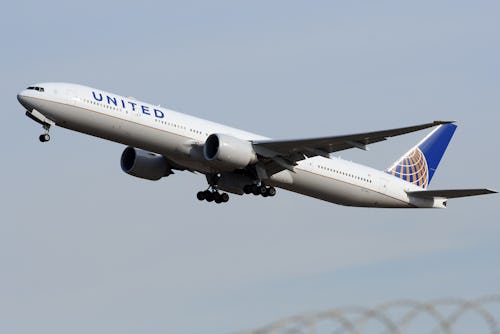United just flew a plane using 100% sustainable fuel
It’s a big deal — but don’t get too excited just yet.

Earlier this week, a United Airlines flight took off from Chicago and landed in Washington, D.C. That typically isn’t a noteworthy achievement, but this flight marked a milestone: It was the first commercial flight completed using entirely sustainable aviation fuel, or SAF.
First, some details about the flight: It was conducted with a Boeing 737 Max 8, the plane with a checkered past that was allowed back in the air last year after two disastrous, deadly, and potentially avoidable crashes in 2019. There were 100 passengers on board the flight. In its fuel tanks was 500 gallons of SAF — a concoction of waste oils which have been converted into a cleaner-burning fuel source. In this case, the SAF was made up of fats, cooking oil, and grease and provided by World Energy. The result, per Boeing, was a flight that emitted 80% less greenhouse gas emissions than conventional jet fuel.
That’s a pretty big deal! Aviation is responsible for more than nearly 1 billion metric tons of carbon dioxide emissions each year and makes up more than 2% of all human-created greenhouse emissions. Cut that by 80% and suddenly the prospect of air travel doesn’t have to be accompanied by the nagging feeling that you’re wrecking the planet.
Don’t go booking your next guilt-free flight just yet, though. While SAFs do hold some promise, they are not currently available at a scale anywhere near necessary to take over the aviation industry. Additionally, SAFs have been around for a while, and some planes already use a mixture of jet fuel and the sustainable alternative; it’s just that previously it was only certified to be blended at up to 50%, and the United flight used 100% SAF.
Still, the prospect of using SAFs entirely is new, and the volume of the material needed is limited. Earlier this year, Delta Airlines CEO Ed Bastian said that an entire year’s worth of the current SAF supply would last the company’s fleet for one day. So ... not great.
Currently, the Department of Energy estimates that it could produce about 50 to 60 billion gallons of SAFs per year, pretty much exclusively by collecting waste and converting it. But actually doing it is costly — about four times as expensive as conventional jet fuel.
SAFs currently represent 1% of available fuel, according to Aviation Today, and scaling up production presents the challenge of potentially creating new environmental risks. It’s a little like the ethanol situation for cars: Yes, it reduces greenhouse gas emissions when used, but the demand for producing the corn crops needed to generate ethanol actually has a negative impact on the planet, causing deforestation and harming biodiversity. This results in ethanol actually producing nearly twice as much carbon dioxide as gasoline over its lifespan, defeating the purpose of its cleaner-burning qualities. A paper published earlier this year by the International Council on Clean Transportation warned that SAFs could suffer the same fate if sustainability is not also top of mind when it comes to harvesting the fuel sources and converting them to jet fuel.
It’s great that United was able to show the viability of SAFs. Now it’s just a matter of scaling up the available fuel in a sustainable way. If we ramp up recklessly, we’ll just be finding new and different ways to destroy the planet.